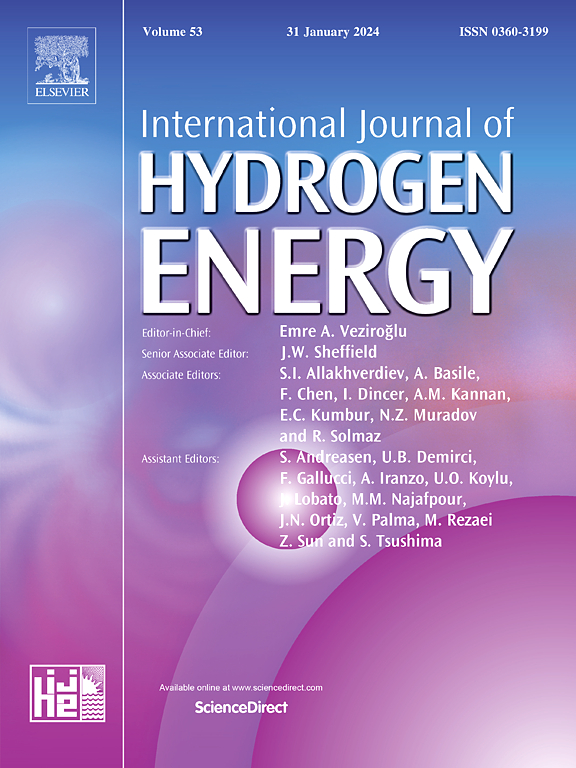Mechanism exploration of the hydrodynamic trapping of hydrogen in geological formations via the pore-scale numerical studies
IF 8.3
2区 工程技术
Q1 CHEMISTRY, PHYSICAL
引用次数: 0
Abstract
Storage of Hydrogen (H2) in subsurface formations is essential for sustainable developments. To unveil the mechanisms behind the H2 trapping potentials in underground reservoirs, pore-scale numerical studies are carried out with help of the digital rock technique and Computational Fluid Dynamics (CFD) approach. The H2 displacing brine as well as the subsequent H2 extraction behaviors are scrutinized in the complex pore geometries of the homogeneous and the fractured porous media. Numerical results show that, only after reaching a certain pressure drop, the injected H2 could break through the brine saturated porous media. The fracture structure could help fulfill the gas flooding brine process at lower pressure drop of 1500 Pa against 2250 Pa in homogeneous porous media. With the similar displacement efficiency of 78.6 % in the fractured media against 79.1 % in the homogeneous core under the elevated pressure drop of 3000 Pa, the limited role of fracture presence on sweep efficiency improvement is observed. Due to the water wet of the fluid-rock system, the subsequent H2 extraction process could be fulfilled at much lower pressure drop levels of 1–50 Pa with the gas trapping ratios below 10 %. Parameter investigation results show the reduction of the IFT and/or altering the H2/brine/rock system from water-wet to intermediate-wet could help substantially the H2 geological storage performances. It is expected the study findings could help understand in mechanism the complicated multiphase displacement characteristics in the complex pore geometries thus offer valuable insights on the H2 geological storage practices.

基于孔隙尺度数值研究的地质地层氢水动力圈闭机理探讨
地下储氢对可持续发展至关重要。为了揭示地下储层中H2捕获电位背后的机制,利用数字岩石技术和计算流体动力学(CFD)方法进行了孔隙尺度的数值研究。研究了均匀多孔介质和裂缝多孔介质复杂孔隙结构中H2驱替盐水以及随后的H2萃取行为。数值结果表明,注入的H2只有达到一定的压降后才能突破盐水饱和多孔介质。在均质多孔介质中,该裂缝结构可在压力降为1500 Pa ~ 2250 Pa的条件下实现气驱盐水过程。在3000 Pa压降下,裂缝介质的驱替效率为78.6%,而均匀岩心的驱替效率为79.1%,表明裂缝存在对波及效率的提高作用有限。由于流体-岩石系统的水湿性,后续的H2萃取过程可以在1-50 Pa的压降水平下完成,气体捕获率低于10%。参数研究结果表明,降低IFT和/或将H2/盐水/岩石体系从水湿型转变为中湿型,可以显著提高H2的地质储集性能。研究结果有助于从机理上理解复杂孔隙结构中复杂的多相驱替特征,从而为储氢地质实践提供有价值的见解。
本文章由计算机程序翻译,如有差异,请以英文原文为准。
求助全文
约1分钟内获得全文
求助全文
来源期刊

International Journal of Hydrogen Energy
工程技术-环境科学
CiteScore
13.50
自引率
25.00%
发文量
3502
审稿时长
60 days
期刊介绍:
The objective of the International Journal of Hydrogen Energy is to facilitate the exchange of new ideas, technological advancements, and research findings in the field of Hydrogen Energy among scientists and engineers worldwide. This journal showcases original research, both analytical and experimental, covering various aspects of Hydrogen Energy. These include production, storage, transmission, utilization, enabling technologies, environmental impact, economic considerations, and global perspectives on hydrogen and its carriers such as NH3, CH4, alcohols, etc.
The utilization aspect encompasses various methods such as thermochemical (combustion), photochemical, electrochemical (fuel cells), and nuclear conversion of hydrogen, hydrogen isotopes, and hydrogen carriers into thermal, mechanical, and electrical energies. The applications of these energies can be found in transportation (including aerospace), industrial, commercial, and residential sectors.
 求助内容:
求助内容: 应助结果提醒方式:
应助结果提醒方式:


